World Heavyweight Championship Title Fight - 26 December 1908
On 26 December 1908, a boxing match was held in Sydney that changed the sport forever and captivated the world. It was the fight for the boxing World Heavyweight Title, between Canadian Tommy Burns, Heavyweight Champion of the World, and challenger for the title African-American Jack Johnson. The Sydney Stadium, an open-air structure of timber and iron in Rushcutters Bay, was host to what was then the largest sporting event in Australia’s history. The fight was stopped in the 14th round and Jack Johnson was declared the winner on points, becoming the first African-American to win the World Heavyweight title.
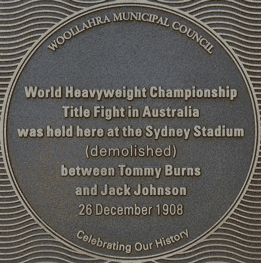
On 11 June, 2019, a plaque commemorating the World Heavyweight Boxing title fight between Tommy Burns and Jack Johnson was unveiled near the site of the Sydney Stadium (demolished), the venue for the fight on 26 December, 1908.
The plaque is located on the footpath on Neild Avenue, near the corner of New South Head Road, Rushcutters Bay.
Watch the plaque unveiling
Gallery
World Heavyweight Championship title fight
26 December 1908
Tommy Burns v Jack Johnson
Sydney Stadium, Rushcutters Bay
On 26 December 1908, an open-air structure of timber and iron in Rushcutters Bay, Sydney, was host to what was, at the time the largest sporting event in Australia’s history: the fight for the boxing World Heavyweight Title, between Canadian Tommy Burns, then Heavyweight Champion of the World, and challenger for the title, African-American Jack Johnson. The fight captivated the world - it was the first time that a black fighter had fought for the prestigious title. In what proved to be a one-sided fight, Jack Johnson was declared the winner in the 14th round of the fight, becoming the first African-American to win the world heavyweight boxing title. Johnson held the title until 1915.
'The bout turned the world on it's head; it was one of the most important moments in history when African-American Jack Johnson, the son of former slaves, battered the white Canadian Tommy Burns for the world heavyweight title, then the most cherished prize in the sporting world.' Kieza, Grantlee. “Boxing in Australia : fighting for equality”, The National Library of Australia Magazine, September 2015.
The Sydney Morning Herald headline on Monday 28 December, 1908 was succinct: “Johnson Wins. World’s First Black Champion” – the article went on to report that
'Johnson won in every department of the game and at every stage of the fight. He represents a class in himself.' Sydney Morning Herald 28.12.1908
Australian promoter and ‘entrepreneur’ Hugh McIntosh had pulled off holding an event of unprecedented significance in Australia, and the Sydney Stadium (roofed over in 1912) was to become an iconic Sydney boxing and entertainment venue until it was demolished in 1970.
The event
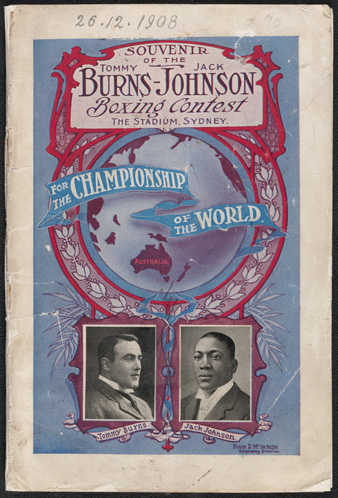
Cover - Souvenir of the Tommy Burns - Jack Johnson boxing contest the Stadium, Sydney. National Library of Australia vn2227362
By 1908, boxing was an established sport in Australia – officers of the NSW ‘Rum’ Corps were known to have staged bare-knuckle bouts between convicts in the early history of the colony, and by the start of the 20th Century, boxing bouts were being held in Australia, Australian boxers were travelling overseas, and bare-knuckle fighter Larry Foley had a well-known academy of Scientific Boxing at the back of the White Horse hotel in George Street, Sydney.i Nevertheless, America had been home to the world championship fights so far.
It was quite a feat for Hugh McIntosh, with little experience as a boxing promoter, to have conceived the idea of staging a heavyweight title fight in Australia to coincide with the arrival of the United States Pacific Fleet, the ‘Great White fleet’ in August 1908. That fight was between Tommy Burns, and the Australian Bill Squires. Unable to find a suitable venue McIntosh leased land at Rushcutters Bay and constructed a stadium, initially conceived as a temporary structure. The American sailors stayed away, but the locals turned up in their thousands. Burns, winning by a knockout in the 13th round, was lauded for the scientific precision of his boxing.
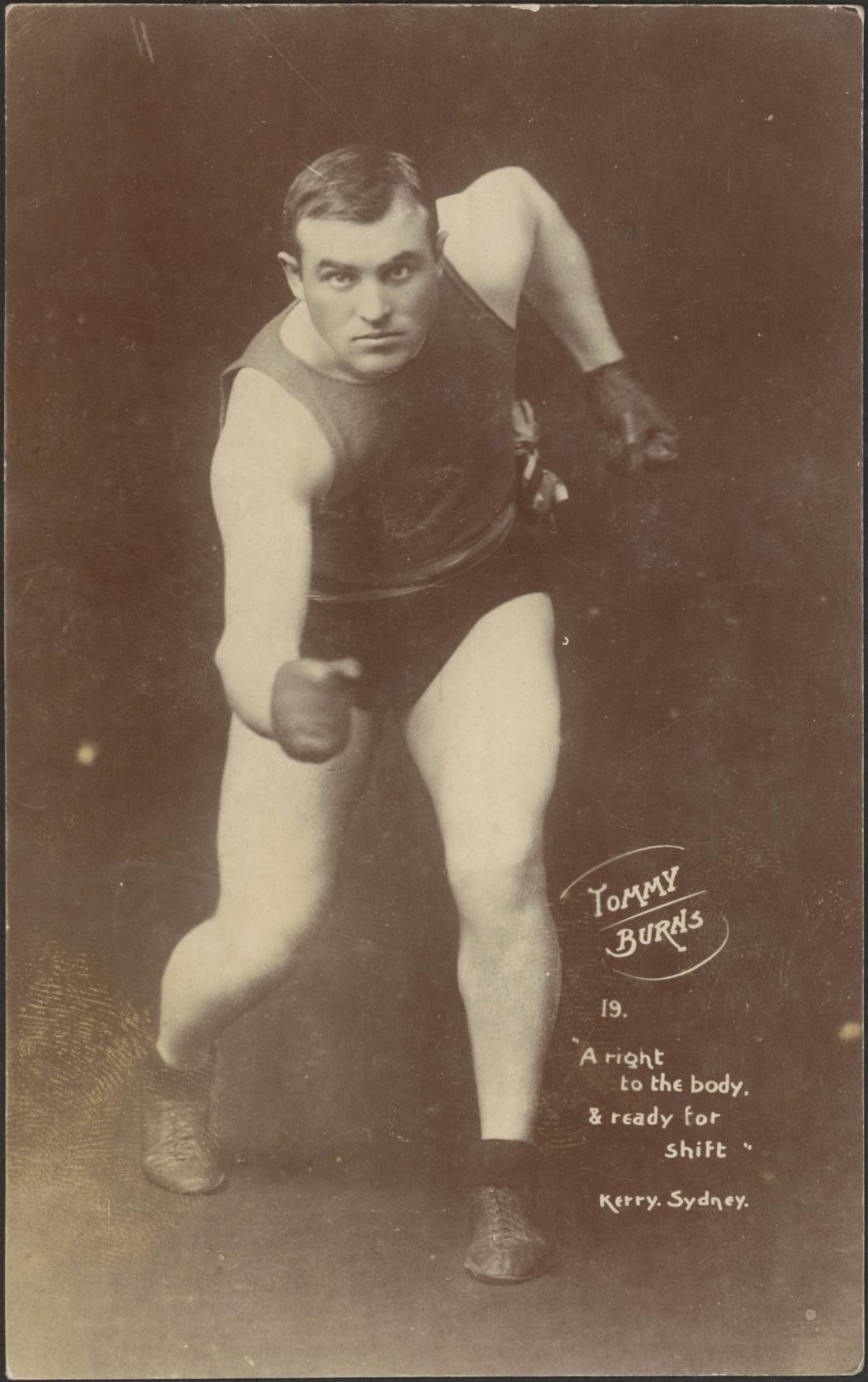
Tommy Burns, Kerry Photo, Sydney, 1908. National Library of Australia vn3789142
Burns stayed on in Australia, becoming something of a favourite with Australian boxing fans despite his win over Squires. Urged by McIntosh he finally agreed to defend his championship against Jack Johnson, who, until that point, had been denied a shot at the title because of his colour.ii
'Who would have thought the boxing championship of the world would be decided in Australia, at Xmas-tide, and for the biggest purse ever presented? Nobody. A suggestion of such a thing, even twelve months ago, would have been laughed to scorn …and so it is that the fact of Johnson and Burns deciding the issue on our soil is exciting jealous comment not only in America, but in England also.' "The World's Boxing Championship". Sunday Times (Perth, WA) 20.12.1908 iii
McIntosh’s staging of the Burns-Squires fight had tapped into a passion for mass spectator sport, and he is thought to have made a huge profit on the Burns-Jackson fight, reportedly taking £26,200.
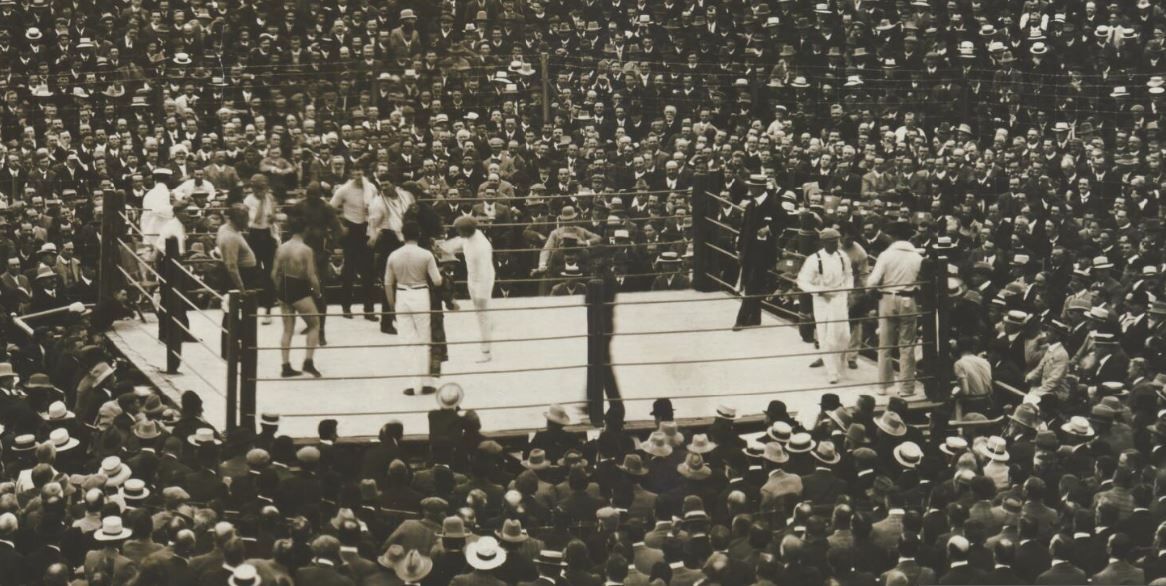
[extract] Burns-Johnson Boxing Contest, Rushcutters Bay, Kerry Photo, Sydney, 1908. National Library of Australia vn3060336.
McIntosh had also arranged for bout to be captured on film and to receive international press coverage – novelist Jack London was among those who recorded the story of Johnson’s stunning victory. The film was produced by locally based Cosens Spencer, and was shown almost immediately after the fight, taking £2,114 in one week in Sydney, and £1,738 in Melbourne over four nights. In January 1909 McIntosh took the film to Europe and the United States of America.iv Only fragments of film survive, but they provide a glimpse of Jack Johnson in action, towering over Burns. Johnson is described as “a theatrical fighter and he can be seen in this footage regularly flashing a smile or holding a proud pose to the crowd to taunt and unsettle his opponent”.v
View the footage, with curators notes, at the NFSA website here: 1908 Burns vs Johnson Boxing match
It would prove to be one of the most one-sided heavyweight title bouts ever held, with police finally stopping the fight in the 14th round, when Burns collapsed.vi
The billing for the event, often exposing the underlying racial tension associated with the fight, was widely covered in the press of the day, both in Australia and overseas.
"On Saturday morning next the Sydney Stadium will be the scene of one of the greatest boxing contests known in the history of the world. Boxing Day of 1908 will be handed down to posterity as the occasion on which, for the first time in the history of fisticuffs, the pugilistic championship of the world has been decided in Australia. It will be a contest of more than average interest: since it will be a battle between one of our own white race and the acknowledged champion of the Ethiopian tribe". The World's Boxing Championship. Sunday Times (Perth, WA) 20.12.1908
Previous goodwill towards Johnson (he had been in Australia previously) seems to have evaporated in the lead up to the Burns-Johnson fight, and although not without supporters, he was treated with suspicion for his flashy lifestyle and his association with white women. He was caricatured in a poster by Norman Lindsay, commissioned by McIntosh : “In the brightly coloured poster that greeted him everywhere, his white opponent was portrayed as a handsome sturdy little hero, while Johnson loomed over him, big, black and threatening”.viii Meanwhile Tommy Burns and his stylish wife Jewel were feted in Sydney.
Overseas, the New York Times had reported more objectively, commenting on Johnson’s capabilities as a boxer :
“Not since the days of James J. Corbett has the prize ring seen so perfect a looking boxer as Johnson. Long and lithe and graceful, he is as true as an arrow in placing his blows. Especially deft is he with his left hand, and few boxers, unless they have great skill, are able to keep the big fighter from beating their faces to tatters".ix
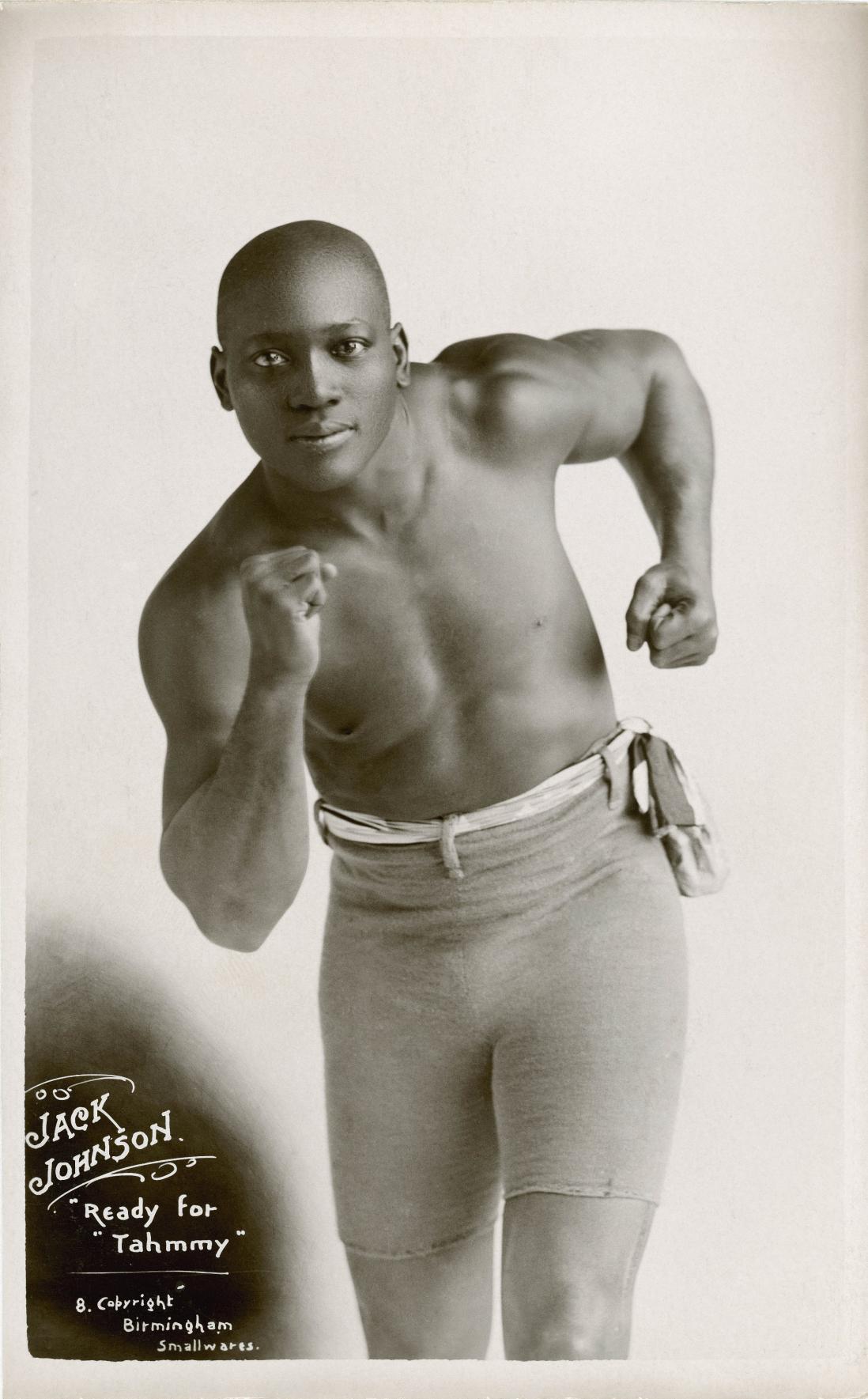
Boxer Jack Johnson of Galveston, Texas, 1908, photographer unknown. National Archives of Australia NAA A1861/855
Reports of attendance at the fight vary, but McIntosh was quoted in a newspaper article in 1916x, saying that Police had estimated the crowd outside the stadium was 40,000, and inside the actual number of ticket holders was 20,200, “which easily constitutes a record and has not been touched in any part of the world since”.
Burns-Johnson Boxing Contest, Rushcutters Bay, Kerry Photo, Sydney, 1908. National Library of Australia vn3060336.

Caption reads:
"Burns-Johnson boxing contest, 14 rounds, won by Johnson on points, Stadium Sydney Dec. 26th, 1908. Purse £7,500. Gate £26,000. Audience 20,000. Referee Hugh D. McIntosh. Kerry, Sydney, Copyright"
While the black press in America was exultant at Johnson’s victory, the result had been a disappointment to the largely ‘white’ crowd - when McIntosh called Johnson the winner, the Stadium was reported to have fallen virtually silent. Within twelve minutes the stadium was empty. The novelist Jack London was ringside to watch the fight, covering the story for the New York Herald. In the aftermath of the fight he led the call to find a ‘White Hope’ following the defeat of Tommy Burns, reflecting the polarisation of opinions regarding Johnson’s victory. London had called the bout “a hopeless slaughter,” and concluded with: “But one thing now remains. Jim Jeffries must now emerge from his alfalfa farm and remove that golden smile from Jack Johnson’s face. Jeff, it’s up to you. The White Man must be rescued.”
Geoffrey C. Ward, in his book Unforgivable Blackness: the rise and fall of Jack Johnson, writes that Johnson said that he had never seen the holding of the heavyweight title as “a racial triumph”,
“but there were those who were to take this view …and almost immediately a great hue and cry went up because a coloured man was holding the championship. The hunt for a white hope began, not only with great earnestness and intentness, but with ill-concealed bitterness. I regretted this phase of the hunt.” xi
Jack (John Arthur) Johnson 31 March, 1878 - 10 June, 1946
Jack Johnson was born on 31 March, 1878, in Galveston, Texas to Henry and Tina Johnson, both former slaves. A professional boxer from 1897 to 1928, Johnson won the world heavyweight championship title in the epic 1908 match against Tommy Burns - he had been a obvious contender for the title heavyweight title for some time before the Sydney match, but had been refused on race grounds. In Sydney for the 1908 fight, Johnson set up his training camp at the Joseph Banks hotel in Botany. Johnson held the title until 1915, when he lost on a knockout to Jess Willard, in Havana.
In 1913, in what has since been considered a racially motivated charge, Jack Johnson was convicted of violating the Mann Act by transporting his wife-to-be across state lines. He fled to Canada, then Europe, staying in exile until 1920 when he returned to the US, serving 8 months in prison. In 2018, the President of the United States issued a posthumous pardon to Johnson.
Jack Johnson died in an automobile accident in 1946, aged 68. Johnson's life has been the subject of several biographies and documentaries, and he was posthumously inducted into the International Boxing Hall of Fame in 1990.
Tommy Burns (Noah Brusso) 17 June, 1881 - 10 May, 1955
Tommy Burns, was born June 17, 1881 in Hanover, Ontario, Canada, and died on May 10, 1955 in Vancouver. Burns excelled as a hockey and lacrosse player as a youth, but turned to boxing, becoming a professional in 1900. First boxing as a lightweight, Burns built himself up to heavyweight division and in 1906 he outboxed Marvin Hart over 20 rounds for the heavyweight championship. At only 5'7" Burns was small but fast, and against larger opponents was known to hold his hands low to score punches. Burns held the heavyweight title for 3 years, until his defeat by Johnson in 1908.
In 1908, Tommy Burns was accompanied to Australia by his wife Jewel, who cut a stylish figure in Sydney. Burns had set up his training camp was at the Hydro Majestic Hotel in the Blue Mountains.
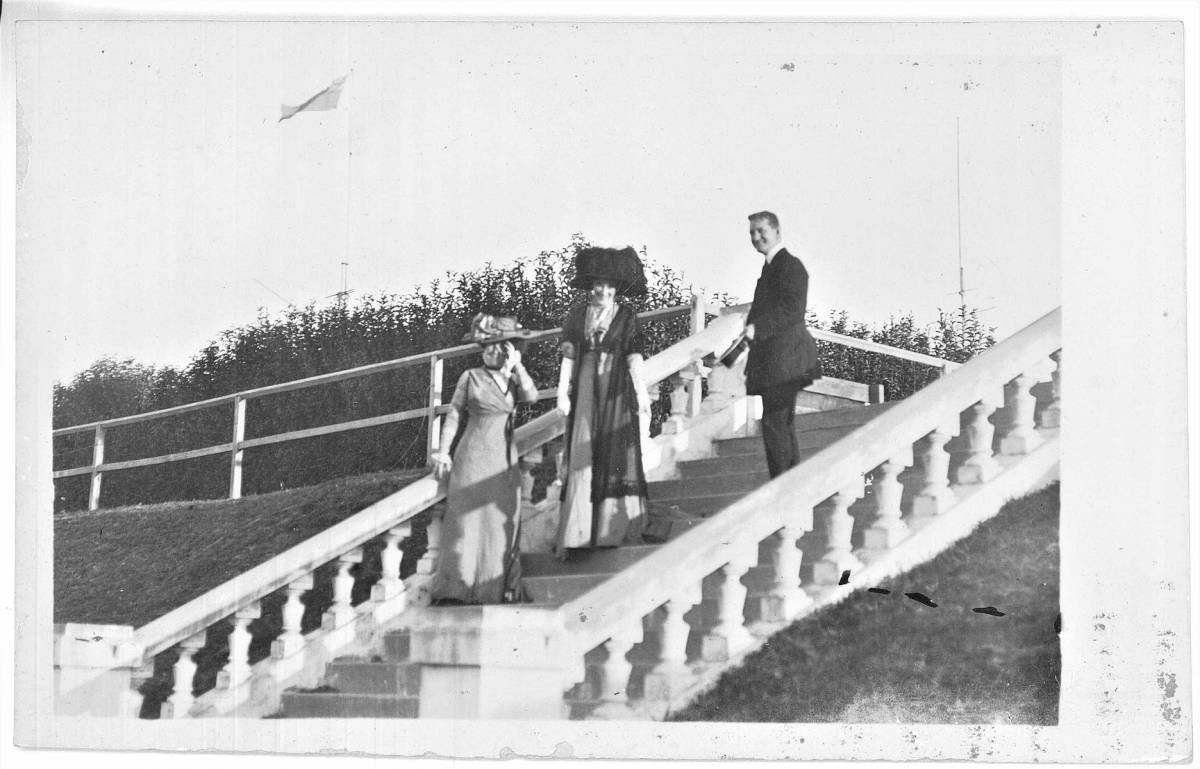
Mrs Mark Foy, Mrs Tommy Burns and manager at Eumemmering Hall, Victoria Road, Bellevue Hill, 1908. Woollahra Libraries Digital Archive pf001582.
Tommy Burns fought only a few more bouts before retiring from boxing in 1920. In retirement, Burns was involved in various business ventures until a religious calling led to his ordination as a minister in 1948. He died of a heart attack in 1955. In 1996 Burns was posthumously inducted into the International Boxing Hall of Fame.
Hugh ‘Huge Deal’ McIntosh - 10 September, 1876 - February, 1942
The Burns-Johnson fight would not have taken place in Australia without Sydney-born Hugh Donald McIntosh. Described in the Australian Dictionary of Biographyxii as a sporting and theatrical entrepreneur and newspaper proprietor, this event and other audacious schemes made him very wealthy at times during his life.
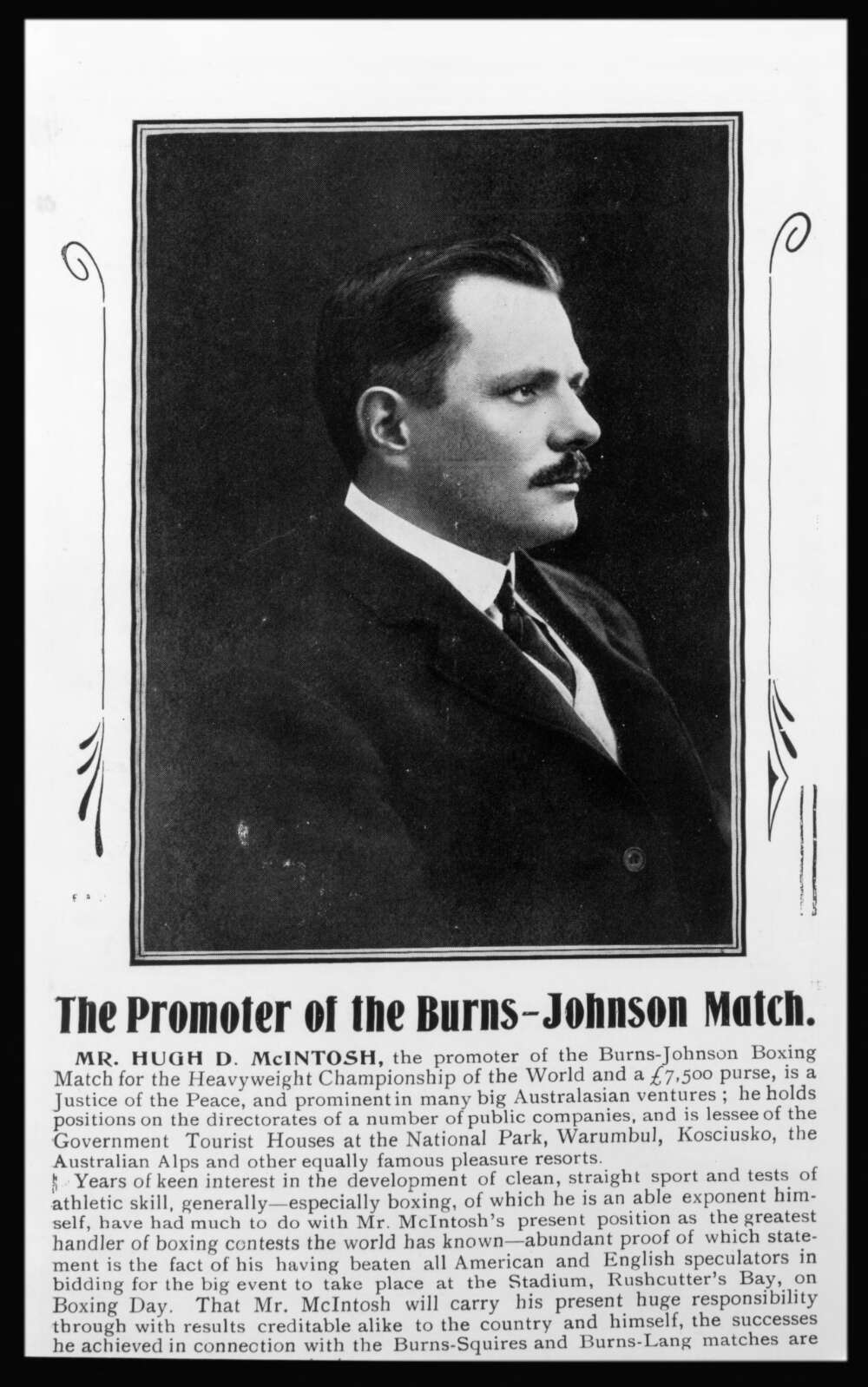
Hugh D Macintosh, promoter of the Burns-Johnson match. National Library of Australia vn3060842
McIntosh’s idea to film the Burns-Johnson bout proved lucrative, matching record takings at the event with records at the box office.
"we went to no end of trouble to secure good film, and had three machines and operators at work..... So far, the greatest possible success has attended our presentation of the fight, and record takings have been put up in Sydney and Melbourne ....not only is the whole fight presented in detail, but films are shown depicting Johnson and Burns going through their training work...Then there are the films showing the crowds flocking to and from the stadium. What a crowd it was! Nothing has ever been seen like it in Australia. Eastern Districts Chronicle 16.01.1909 p3" xiii
During the war years, H D McIntosh was associated with the “Rose Bay Continental Gardens” outdoor cinema and his wife Marion (nee Backhouse) was an active supporter of the war effort waged on the home front by the Vaucluse Red Cross, and was able from time to time to secure both venues operated by her husband for war-time fundraisers and entertainments. McIntosh also purchased Bellhaven, a mansion at Bellevue Hill, in 1919, which he extensively renovated before selling it when he moved to the UK in the 1920s.
Sydney Stadium, Rushcutters Bay
The Sydney Stadium was initially conceived as a temporary structure, constructed by promoter H D McIntosh for the World Heavyweight Boxing title fight between Canadian Tommy Burns and Australian Bill Squires in August 1908. Burns won the match, but was persuaded by H. D. McIntosh to stay in Australia and defend his championship against the American Jack Johnson in the historic bout which took place at the Sydney Stadium on 26 December 1908. In the years following the Johnson-Burns match, the Sydney Stadium was roofed over and enlarged, becoming a more permanent structure, albeit of wood and galvanised iron, affectionately known as the 'old tin shed'. It was to become an iconic Sydney boxing and entertainment venue until it was demolished in 1970, hosting numerous boxing bouts and playing host to The Beatles, Louis Armstrong, Frank Sinatra, Buddy Holly, and The Rolling Stones, as well as Symphony orchestras and religious evangelists. Boxing promoter and stadium manager, Henry Lawrence (Harry) Miller managed the Stadium for 33 years.
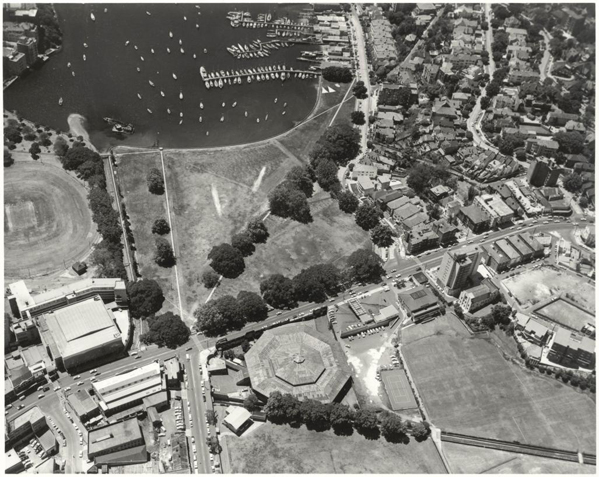
Aerial view of Sydney Stadium at Rushcutters Bay, Ern McQuillan, 1968. National Library of Australia vn3562173 © Estate of the artist
A plaque denotes the site of the Sydney Stadium, mounted on the face of a sandstone block base, located in the grassed open space bordered by the extension of Craigend Street and the Eastern Suburbs Railway Viaduct, Rushcutters Bay, beneath the railway overpass at the bottom of a slope some 14 m. from the kerb. The inscription reads:
This plaque was unveiled by the Hon. K. G. Booth, M.P., Minister for Sport and Recreation to commemorate Sydney Stadium which was located at this site from 24 August, 1908 to 9 October, 1970. C. B. A.Widdy, Mayor, Woollahra Municipal Council 19th December 1980.
Source: 'Monuments and Memorials in Woollahra', compiled by the Woollahra History and Heritage Society.
Significance
In the introduction to his 1998 book “Boxing Day: the fight that changed the world” author and boxing commentator Jeff Wells wrote that he became interested in the Burns-Johnson fight, “not just as a boxing writer, but as an Australian puzzled as to why this momentous event had not become engraved on my nations’s sporting consciousness”:
It is remarkable that it was in Australia, of all places, a dot on the great steamer routes, that the egregious ‘colour line’ - the shameful battlement behind which supposedly great knucklemen had hidden while proclaiming themselves ‘champions of the world - was torn down.
Ken Cotterill, a playwright and boxing coach, further noted that once the Sydney Stadium was demolished in 1970, there was now nothing to mark this incredible moment in sporting history.
In recognition of the significance of the event, on 11 June, 2019 Woollahra Council commemorated the occasion by unveiling a plaque at the site of the former Sydney Stadium. The circumstances of this event continue to be of interest to the boxing fraternity and the community as a whole.
Linda Haywood, great-great niece of Jack Johnson, expressed the family’s thanks to Woollahra Council for this initiative:
“On behalf of myself and the family of the First Black Heavyweight Champion of the World Jack Johnson I would like to humbly and graciously thank the city of Rushcutters Bay, Australia for recognizing and acknowledging the historical event that occurred over 100 years ago which commemorates my uncle Jack Johnson's obtaining the title of Heavyweight Champion of the world. My family and I are so very proud of his accomplishments and his posthumous pardon. I will continue to celebrate and preserve his legacy throughout the family and the world. Thank you.”. Linda Haywood June 2019.
On the occasion of the unveiling of the plaque, the President of the World Boxing Council, Mr Mauricio Sulaiman sent the following message, acknowledging the importance of this event:
"The World Boxing Council proudly joins this memorable ceremony as the world celebrates the unveiling of a plaque to commemorate the World heavyweight boxing championship, which was held between Tommy Burns and Jack Johnson at the Sydney Stadium in Rushcutters Bay in 1908. This was the first ever heavyweight fight between a black and a white man which was of tremendous importance as the world was living through a horrific discrimination and abuse in those days. We all celebrate that just after one year of the Presidential Pardon by USA President Donald Trump on May 2018, Australia is commemorating again Jack Johnson and his legacy. The World Boxing Council joins the local authorities in this humanitarian event, which is great for boxing and inclusion". Mauricio Sulaiman, WBC President, June 2019.
Beston, Paul. “Jack Johnson crosses the line, 1908" Paul Beston Blog, retrieved from https://paul-beston.squarespace.com/blog/jack-johnson-1908
Cunneen, Chris. "McIntosh, Hugh Donald (1876–1942)", Australian Dictionary of Biography, 1986
De Souza, Poppy. “Curator’s Notes: Johnson vs Burns: 1908”. National Film and Sound Archive at https://aso.gov.au/titles/historical/boxing-1908-johnson-vs-burns/clip1/
Kieza, Grantlee. “Boxing in Australia : fighting for equality”. The National Library of Australia Magazine, September 2015
Smith, Terry, The old tin shed: Sydney Stadium 1908-1970, North Sydney, N.S.W. : Eric Spilsted Publishing, 1999
Ward, Geoffrey C. Unforgivable Blackness: the rise and fall of Jack Johnson. New York. A.A. Knopf. 2004.
Wells, Jeff. Boxing Day : the fight that changed the world. Sydney, Harper Collins, 1998.
TROVE, National Library of Australia
Footnotes
i Smith, Terry, The old tin shed: Sydney Stadium 1908-1970, North Sydney, N.S.W. : Eric Spilsted Publishing, 1999. p 24
ii Smith, Terry, The old tin shed: Sydney Stadium 1908-1970, North Sydney, N.S.W. : Eric Spilsted Publishing, 1999. p 22
iii The World's Boxing Championship (1908, December 20). Sunday Times (Perth, WA : 1902 - 1954), p. 8 (THIRD SECTION).
iv Chris Cunneen, "McIntosh, Hugh Donald (1876–1942)", Australian Dictionary of Biography, National Centre of Biography, Australian National University, http://adb.anu.edu.au/biography/mcintosh-hugh-donald-7373/text12811
v De Souza, Poppy, "Boxing 1908: Johnson vs Burns" Australian Screen : an NFSA website, retrieved from https://aso.gov.au/titles/historical/boxing-1908-johnson-vs-burns/notes/
vi Beston, Paul. “Jack Johnson crosses the line, 1908" Paul Beston Blog retrieved from https://paul-beston.squarespace.com/blog/jack-johnson-1908
viii Ward, Geoffrey C. Unforgivable Blackness: the rise and fall of Jack Johnson. New York. A.A. Knopf,2004
ix Beston, Paul. “Jack Johnson crosses the line, 1908" Paul Beston Blog retrieved from https://paul-beston.squarespace.com/blog/jack-johnson-1908
x "Bright Burns-Johnson Sidelights" Referee July 19, 1916 p. 16. Retrieved from http://nla.gov.au/nla.news-article121169785
xi Ward, Geoffrey C. Unforgivable Blackness: the rise and fall of Jack Johnson. New York. A.A. Knopf, 2004. p124
xii Chris Cunneen, "McIntosh, Hugh Donald (1876–1942)", Australian Dictionary of Biography, National Centre of Biography, Australian National University, http://adb.anu.edu.au/biography/mcintosh-hugh-donald-7373/text12811
xiii "The Great Fight" Eastern Districts Chronicle, January 16, 1909 p. 3. Retrieved from http://nla.gov.au/nla.news-article148615994
New plaques are added based on nominations from the community, which are then assessed against selection criteria and researched by a Local History Librarian.
Find out more and nominate a person or event for a plaque.